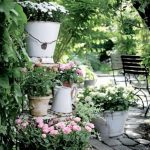Are you looking for garden ideas for long narrow gardens? Long, narrow gardens present both challenges and opportunities when it comes to design and landscaping. In this article, we will explore creative solutions to make the most of these unique spaces. From utilizing vertical space to choosing the right plants and creating distinct zones, we will cover a range of strategies to transform your long narrow garden into a functional and visually appealing outdoor oasis.
Long, narrow gardens often pose challenges in terms of layout and design. However, with the right approach, they can also offer exciting opportunities for creative landscaping. By understanding the specific characteristics of these spaces, we can uncover innovative ways to maximize their potential. Whether you’re dealing with a small urban backyard or a longer suburban plot, there are numerous possibilities to consider when it comes to planning and designing your garden.
In this article, we will delve into various aspects of designing long narrow gardens, including utilizing vertical space, choosing the right plants, creating distinct zones, maximizing the boundaries, incorporating pathways, enhancing lighting and ambiance, maintaining balance, and exploring real-life case studies of successful long narrow gardens. Whether you’re an experienced gardener or a novice enthusiast, these valuable insights and ideas will help you make the most of your long narrow outdoor space.
Utilizing Vertical Space
Long narrow gardens present a unique set of challenges and opportunities when it comes to landscaping and design. One of the key strategies for making the most of this type of space is to utilize vertical space effectively. By thinking creatively and incorporating elements that add height and visual interest, you can transform a long narrow garden into a stunning and functional outdoor oasis.
One creative way to add height to a long narrow garden is by incorporating trellises, pergolas, or archways. These architectural features not only provide vertical interest, but they also create an opportunity to incorporate climbing plants such as jasmine, clematis, or ivy. This can help soften the boundaries of the garden and create a lush, green backdrop.
In addition to vertical structures, another effective way to add height in a long narrow garden is through the use of tall planters or raised beds. These can be used to create layers of planting at different heights, adding depth and visual appeal to the space. Tall grasses, small trees, and ornamental bamboo are all great choices for adding vertical elements while maximizing limited ground space.
| Vertical Space Element | Examples |
|---|---|
| Trellises, pergolas, or archways | Jasmine, clematis, ivy |
| Tall planters or raised beds | Tall grasses, small trees, ornamental bamboo |
By incorporating these vertical elements into your long narrow garden design, you can create a sense of drama and dimension while making the most of limited space. This approach not only adds visual interest but also allows for more efficient use of the available square footage. With careful planning and creativity, any long narrow garden can become a beautiful and inviting outdoor retreat.
Choosing the Right Plants
When it comes to designing a long narrow garden, choosing the right plants is crucial to make the most of the space and create a visually appealing environment. Here are some garden ideas for long narrow gardens when it comes to selecting flowers, shrubs, and trees:
- Consider planting vertical or columnar trees such as Italian cypress, slender hinoki cypress, or tall and narrow junipers. These trees can add height without taking up too much horizontal space, making them perfect for long narrow gardens.
- Opt for narrow and upright shrubs like boxwood, sky pencil holly, or tall grasses such as feather reed grass or switchgrass. These plants can be used to create visual screens or dividers within the garden while adding texture and interest.
- Choose flowers that thrive in limited space such as tall and slender perennials like foxgloves, delphiniums, or hollyhocks. These plants can add pops of color and vertical interest without encroaching on neighboring areas.
In addition to these options, incorporating climbing plants such as jasmine, ivy, or clematis can also help maximize vertical space while adding a lush and verdant feel to the garden. By carefully selecting plants that are suited for narrow spaces, you can create a beautiful and thriving garden that maximizes every inch of your long narrow outdoor area.
Creating Distinct Zones
Long narrow gardens can present a unique set of challenges when it comes to creating distinct zones within the space. However, with the right planning and design, these gardens offer a fantastic opportunity to create functional and visually appealing areas that make the most of the available space. Here are some creative ideas for dividing your long narrow garden into distinct zones.
- Use planters or raised beds: Creating raised planting areas can help to visually break up the space, while also providing an opportunity to grow a variety of plants. Consider using different types of planters or raised beds for each zone to add visual interest.
- Install trellises or screens: Adding trellises or screens can help to define different areas within your garden, providing privacy and separation between zones. These features also offer opportunities for vertical gardening by allowing climbing plants to grow upwards.
- Introduce hardscaping elements: Incorporating pathways, patios, or decking can help to create functional zones within your garden. Use different materials or designs for each area to distinguish them from one another.
In addition to physically dividing your long narrow garden into distinct zones, consider utilizing different themes or color schemes for each area. For example, you could create a vibrant flower garden in one zone, a peaceful meditation area in another, and a productive vegetable patch in another.
By carefully planning and designing the different zones within your long narrow garden, you can maximize the functionality and visual appeal of the space while making the most of its proportions. With some creativity and thoughtful consideration, your garden can be transformed into a series of interconnected yet distinct areas that enhance its overall beauty and usability.
Maximizing the Boundaries
Utilizing the edges of a long narrow garden is crucial for making the most of the space and creating a functional and visually appealing outdoor area. When it comes to maximizing the boundaries, there are several creative ways to utilize the edges of the garden for seating, storage, or planting. Here are some garden ideas for long narrow gardens that will help you make the most of your outdoor space.
One popular idea for maximizing the boundaries of a long narrow garden is to create built-in seating along one or more edges. This not only provides a place to sit and relax but also helps define different areas within the garden. Built-in benches or seating can be incorporated into retaining walls, raised planters, or along fences to make efficient use of space while adding functionality to the garden.
In addition to incorporating seating into the edges of the garden, using vertical storage solutions such as shelves, trellises, or hanging planters can help maximize space and add visual interest. Vertical gardening allows you to make use of otherwise unused wall or fence space for planting, which can be especially helpful in a long narrow garden where ground space may be limited.
Another creative way to utilize the boundaries of a long narrow garden is by incorporating edging plants or ornamental grasses along the edges. These plants not only soften hardscapes and add texture but also help define different zones within the garden. Choosing plants that thrive in narrow spaces and can withstand varying light conditions is essential for creating a cohesive and visually appealing outdoor area.
| Garden Ideas | Long Narrow Gardens |
|---|---|
| Built-in seating | Efficiently uses space |
| Vertical storage solutions | Adds visual interest |
| Edging plants and ornamental grasses | Define different zones |
Incorporating Pathways
When it comes to designing a long narrow garden, incorporating pathways is crucial for both practicality and visual appeal. One of the key challenges of this type of garden is creating a sense of movement and flow within the space, and well-designed walkways can help achieve this. Additionally, pathways offer the opportunity to add interest and personality to the garden through creative design and materials.
One of the best garden ideas for long narrow gardens is to opt for curved or meandering pathways rather than straight lines. Curved paths can create a more natural and organic feel, while also helping to visually expand the space by creating a sense of discovery as one moves through the garden. Consider using materials such as gravel, stepping stones, or even turf to create these meandering walkways, adding texture and visual interest to the design.
Incorporating focal points along the pathways can also enhance the visual appeal of a long narrow garden. Whether it’s a strategically placed sculpture, an eye-catching plant or flower bed, or a charming sitting area, these focal points can break up the linear nature of the space and draw attention to specific areas of interest.
By carefully considering the placement of these features along the pathway, you can effectively guide visitors through the garden while adding intrigue and beauty to the overall design.
Lighting and Ambiance
When it comes to long narrow gardens, strategic lighting and decor can make a world of difference in creating an inviting and enchanting outdoor space. By carefully considering the placement of lights and the addition of decorative elements, you can transform your garden into a magical oasis that is both functional and visually appealing.
Strategic Lighting Placement
One of the most effective ways to enhance a long narrow garden is through strategic lighting placement. In a limited space, it’s important to maximize the impact of each light fixture. Consider installing wall-mounted sconces along the boundaries or using string lights to create a cozy atmosphere. Pathway lights can not only illuminate walkways for safety but also add a touch of charm to the garden.
Decorative Elements
In addition to lighting, incorporating decorative elements can elevate the ambiance of your long narrow garden. This could include adding outdoor artwork, sculptures, or even water features that create a focal point and draw the eye along the length of the space. Choose pieces that complement the style of your garden and reflect your personality to truly make the space your own.
Creating Atmosphere
When planning your lighting and decor scheme, think about the atmosphere you want to create in your long narrow garden. Soft, warm lighting can evoke a cozy and intimate feel, while brighter lights may be better suited for entertaining areas or spaces where you want to showcase specific features. By carefully considering how different elements work together, you can ensure that your garden feels welcoming and enchanting throughout its length.
Maintaining Balance
Creating a visually balanced and harmonious garden in a long narrow space can be quite challenging, but with the right techniques, it is certainly achievable. One effective way to maintain balance in a long narrow garden is by creating symmetry.
Symmetrical planting, where identical or similar elements are placed on either side of a central axis, can help create a sense of balance and harmony. This can be achieved by using matching pairs of plants, seating areas, or decorative features such as sculptures or trellises.
Utilizing Focal Points
Another strategy for maintaining balance in a long narrow garden is to utilize focal points. Focal points draw the eye and create visual interest, helping to distract from the garden’s narrowness. Consider incorporating a striking sculpture, water feature, or even a colorful flowering tree as a focal point in the center or at the end of the garden. By strategically placing these focal points, you can help create a sense of equilibrium throughout the space.
Layering Plants and Structures
Incorporating layers into your long narrow garden design can also contribute to creating visual balance. Use plants of varying heights and textures to add depth and dimension to the space. Additionally, consider adding structures such as arches, pergolas, or trellises at different intervals along the length of the garden. These vertical elements not only add visual interest but also help break up the linear nature of the space, contributing to a more balanced overall look.
By employing these techniques and considering how each element interacts with the others within your long narrow garden, you can achieve a balanced and harmonious outdoor space that feels cohesive and inviting.
Case Studies
In conclusion, creating a beautiful and functional long narrow garden may seem daunting at first, but with the right strategies and ideas, it can become a stunning outdoor space. By understanding the challenges and opportunities of these unique garden layouts, homeowners can utilize vertical space, choose the right plants, create distinct zones, maximize the boundaries, incorporate pathways, and enhance the overall ambiance with lighting and decor.
It’s important to maintain balance throughout the design process to ensure a visually appealing and harmonious garden.
One of the key takeaways from successful long narrow gardens is the careful consideration of how to divide the space into functional areas while maintaining visual appeal. Whether it’s creating a cozy seating area along one boundary or incorporating storage solutions into the design, maximizing every inch of the garden is essential for its success.
Additionally, choosing plants that thrive in narrow spaces and implementing creative ways to add height can transform a long narrow garden into a lush and vibrant oasis.
For inspiration and practical guidance, homeowners can look to real-life case studies of successful long narrow gardens. These examples showcase innovative strategies for making the most of limited space, whether it’s through clever use of vertical elements or strategic placement of pathways. By drawing inspiration from these case studies and implementing some of the suggested garden ideas for long narrow gardens, anyone can create a stunning outdoor retreat regardless of their garden’s dimensions.
Frequently Asked Questions
How Do You Landscape a Long Narrow Area?
Landscaping a long narrow area requires careful planning to ensure the space is utilized effectively. Installing pathways, using vertical elements like trellises or tall plants, and creating different zones can help break up the space and make it visually appealing.
How Do You Break Up a Long Narrow Garden?
Breaking up a long narrow garden can be achieved by incorporating different elements such as raised beds, planting in staggered rows, adding focal points like statues or water features, and using varying textures and colors to create visual interest throughout the space.
How Do You Plant a Narrow Garden?
Planting a narrow garden involves selecting plants that fit the scale of the space and considering their mature size to prevent overcrowding. Using a mix of shrubs, perennials, and ornamental grasses can add depth and dimension to the garden while also providing year-round interest.
Proper spacing and thoughtful placement are key to ensuring the garden thrives in its confined space.

Welcome to my gardening blog! I am passionate about plants and enjoy sharing my knowledge and experiences with others. In this blog, I will write about everything related to gardening, from tips on how to get started to updates on my own garden projects.





